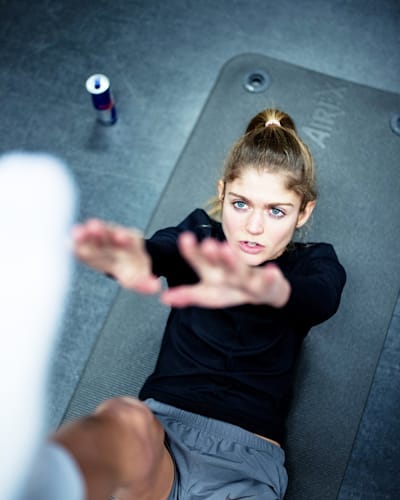
Fitness Training
Small but mighty, stability exercises make a real difference for even world-class athletes like Konstanze Klosterhalfen. Here she explains which exercises help her perform while running.
Body stabilising exercises are a must for every athlete, especially runners. There are three good reasons to integrate stability training into your training routine – they train your balance; they improve coordination; and they help to prevent injuries. If you're planning to take part in this year's Wings For Life World Run, which you really should be, get started on these exercises now so you can be at your best on May 4, 2025.
01
What are stability exercises and why are they important?
"Stability exercises primarily serve to prevent injuries, because they compensate for imbalances and strengthen and stabilise the torso and back," says triathlon ace Sebastian Kienle from his own experience, hitting the nail on the head from a sports science perspective.
Runners in particular benefit from stability training by strengthening the deep and holding muscles around their joints, especially the torso around the abdomen and back. The desired physical adaptations can be additionally optimised with the help of the right nutrition.
Stability exercises also improve the body's balance by correcting issues such as imbalances or different strength levels between left and right legs or left and right arms.
"Stability training is extremely important for me to improve my body's stability," emphasises running ace Konstanze Klosterhalfen. "More stability is important for my running economy, but it also helps prevent injuries. For example, I notice immediately if I neglect my stability exercises for the deep gluteal muscles for a while. I have more knee pain immediately after running."
02
Stability training vs strength training
For runners, stability exercises have another advantage. While stability training makes the body and joints stronger, and more resistant from the inside, it doesn't lead to undesired weight gain through muscle growth - unlike classic strength training.
This is another reason why Klosterhalfen completes a short 20-minute stability program at least four times a week after her running sessions: "It's a chore that's not necessarily fun, but that makes it all the more worth it."
03
These are the 12 best stability exercises for runners
1. Plank/forearm support
The plank is the mother of all stability exercises and is as inconspicuous as it is effective. It trains almost every muscle in your body from the core to the shoulders, buttocks and legs.
How to do it: Lean on your forearms so that your elbows are about shoulder-width apart and flat on the floor directly under your shoulders. Your neck, back, hips and legs form a line. Your toes also touch the floor slightly closer than hip-width. Hold this position without lowering your hips for 30 to 60 seconds. Depending on your fitness level you can do two to three sets before moving on to the next exercise.
2. Side plank
With the side plank you mainly train your lateral abdominal muscles, but also your shoulder and leg muscles.
How to do it: Start in a lateral position. Your elbow is in line with your shoulder, your forearm is flat on the floor and your legs are stretched out and lying on top of each other. Press up from this position until your hips are in line with your legs, back and neck. Hold this position for 30 to 60 seconds per side. Depending on your fitness level, you can do two to three sets before moving on to the next exercise.
Variation: Raise and lower your hips slowly and in a controlled manner from the start position to the end position and back.
3. Sit-ups/ crunches
Probably the best-known stability exercise of all is the crunch, also called sit-up. There are countless variations of them, all of which train your abdominal muscles in particular. Here, we introduce you to crunches for the straight abdominal muscles.
How to do it: Start in a supine position, with your legs bent so that your hips and knees are each at a 90 degree angle. From this position, slowly and in a controlled manner lift your upper body two hand widths off the floor using only your abdominal muscles. Your gaze should go over your knees, ideally also to the ceiling. Then, return your upper body in a controlled manner to just before the starting position without completely lowering your upper body. Repeat this exercise 10-20 times. Depending on your fitness level you can do two to three sets before moving on to the next exercise.
4. Push-up
Push-ups are another highly effective full-body exercise. They work every muscle in your body, but especially your arms, chest and shoulder muscles.
How to do it: Start in a prone position, legs stretched together, toes on the floor, palms flat on the floor at chest level, fingers pointing forward. From this position, push yourself powerfully upwards until your arms are fully extended. Your body should be firm and straight like a board. Then, lower your body back towards the floor until your chest just touches the floor. Repeat this exercise 10-20 times. Depending on your fitness level, you can do two to three sets before moving on to the next exercise.
Simplified: If you find this type of push-up too difficult, you can place your knees on the floor instead of your toes and push yourself up and down from this position.
5. Air squat
The air squat is one of the most effective leg exercises of all. Even without additional weights, squats strengthen your legs and torso in the long term.
How to do it: Start in a standing position. Legs slightly over shoulder width, toes pointing forward and slightly outward, arms extended straight in front of the body. The upper body is upright. Now slowly lower your buttocks as far as you can in a controlled manner while keeping your upper body straight. Then press forcefully back to the starting position. Repeat this exercise 10-20 times. Depending on your fitness level you can do two to three sets before moving on to the next exercise.
6. Single leg deadlifts
Single leg deadlifts sound spectacular and they are - especially in terms of injury prevention. They not only strengthen the back of your thighs, buttocks and core muscles, but they also improve your balance and coordination and stabilise your knee joints.
How to do it: Start in an upright single-leg stance. Your standing leg is slightly bent at the knee joint, the free leg slightly raised off the floor and your arms relaxed beside your body. From this position, bend forward slowly and in a controlled manner like a scale over your supporting leg. Slowly bring your outstretched arms towards the floor and your free leg stretched backwards and upwards towards the ceiling until your upper body is horizontal to the floor and the heel of your free leg is in line with your hips and shoulders. Then, return your upper body to the starting position in a controlled manner. Repeat this exercise five to 10 times per side. Depending on your fitness level you can do two to three sets before moving on to the next exercise.
7. Nordic hamstring curls (advanced only)
This highly efficient exercise to strengthen the hamstrings works wonders, but is only recommended for advanced exercisers. Hamstring curls on the floor are an easier alternative exercise (see below).
How to do it: Start in a hip-width kneeling position with your upper body upright. If you don't have a partner who can fix your ankles, you can fix your feet under a heavy piece of furniture fixed to the wall. From the upright position, lower your tense upper body slowly and in a controlled manner towards the floor as far as you can. If the strain becomes too intense, drop to the floor and cushion yourself with the help of your arms, similar to a push-up, and immediately push yourself back up to the starting position. When lowering your upper body, make sure that your abdomen is tense and that your back isn't arched. Repeat this exercise five to 10 times.
Simplified version: Do the hamstring curls on the floor. Lie flat on your back with your legs bent at 90 degrees and your toes pulled towards your shins so that only your heels are on the floor, ideally on a slippery surface. Now, raise your hips until they're in line with your shoulders and knees. Hold this position and then push your heels away from your buttocks until your legs are almost extended and your bottom is almost touching the floor. Then, pull your heels back towards your buttocks until your hips are again in line with your shoulders and knees and your knees are again at a 90 degree angle. Repeat this exercise five to 10 times. Depending on your fitness level you can do two to three sets before moving on to the next exercise.
8. Glute bridge/pelvic lift
The glute bridge, also known as the pelvic lift, is a simple and highly effective stability exercise to strengthen your glutes and hamstrings.
How to do it: Lie flat on your back on the floor. Your legs are hip-width apart and bent about 90 degrees at the knee. The soles of your feet should be in contact with the floor throughout the exercise. Now raise your pelvis until it forms a straight line with your shoulders and knees. Hold this position for a few seconds. Then, slowly lower your hips in a controlled manner until your bottom touches the floor. Repeat this exercise 10 times. Depending on your fitness level, you can complete two to three sets before moving on to the next exercise.
Progressions: To make the exercise more difficult, you can perform it with a mini band that sits above your knees. Alternatively, you can perform the glute bridge by keeping one leg on the floor and extending the other.
9. Back extensions/supermans
A good exercise to strengthen the back, glutes and hamstrings are back extensions, also called supermans.
How to do it: Lie flat on your stomach. Start with your arms and legs stretched out on the floor as an extension of your body. Now lift both arms and legs slowly and controlled about 10cm from the floor. Hold the tension at the top for a few seconds and then lower your outstretched arms and legs slowly and in a controlled manner to the floor. Repeat this exercise 10-15 times. Depending on your fitness level you can do two to three sets before moving on to the next exercise.
Variation: Instead of lifting both legs and both arms, alternate lifting the right leg and left arm, and then the left leg and right arm.
10. Banded clam shells
Perhaps the best exercise to prevent knee pain! "Clam shells are one of those exercises where I notice immediately if I haven't done them for a while," Klosterhalfen confesses. "If I neglect them for a while, I go straight back to having more knee pain after running."
How to do it: Lie sideways on the floor, supporting your head with your lower arm, your upper arm relaxed on your lower belly or on the floor in front of it and your abdominal muscles slightly tensed. Your legs will be bent about 90 degrees and lie on top of each other. The mini-band sits above your knees. Now slowly open your knees as wide as you can without rotating your hips. Your heels should always touch. Then, slowly bring your knees together again in a controlled manner. Repeat this exercise 10-15 times per side. Depending on your fitness level, you can do two to three sets before moving on to the next exercise.
Simplified: The exercise is easier without the mini band and it still remains effective.
11. Calf raises
"Calf raises not only make beautiful calves, it's also a good preventive exercise against Achilles tendon problems," Sebastian Kienle says. "Calf raises help strengthen the Achilles tendon." In fact, there's a significant correlation between the springiness of the Achilles tendon, so to speak, and athletes' best times. The 2014 Ironman winner speaks from experience after enduring Achilles tendon problems, so follow his lead.
How to do it: Stand about shoulder-width apart, feet parallel. Now push yourself up into a high toe stand using only your calf muscles. Then, lower your feet back to the floor in a controlled manner. Repeat this exercise 10 times.
Progression: Without shoes this exercise is much more challenging.
12. Toe raises
The counterpart exercise to calf raises, which Kienle has been swearing by for several years: "Toe raises strengthen the shin muscles. Runners often have problems here, for example with 'shin splints', especially after exertion. This exercise helps prevent that.
How to do it: Sit on a chair with your feet parallel to the floor, slightly less than shoulder width apart. Alternately pull your toes as far towards your shins as you can and then slowly back to the floor. Repeat this exercise 10-15 times. Depending on your fitness level you can do two to three sets before moving on to the next exercise.
Progression: The faster you perform the exercise, the more strenuous it becomes. However, even at a higher speed, make sure you perform the exercise cleanly.
Why do we care about running? There are of course the mental and physical benefits of putting on a pair of trainers and stretching your legs, but the big one is the Wings For Life World Run which looks to raise funds to support spinal cord research. Every year, people around the world run globally for those that can't and this year's event will take place on May 4. Find out how you can be part of this incredible event here.






















